Herbert Case Study: Examining Health and Social Determinants
VerifiedAdded on 2022/11/26
|8
|1681
|462
Case Study
AI Summary
This case study analyzes Herbert, a 65-year-old man with chronic hypertension, examining the complex interplay of his health, lifestyle, and social environment. The analysis delves into the impact of his semi-retired status, marital difficulties, and limited social support on his well-being. It explores factors such as an unhealthy lifestyle, low self-esteem, social isolation, and ongoing stress, as well as cultural influences like his preference for junk food and alcohol. The study also investigates the psychosomatic effects of his mental state on his physical health, his stress levels, and the coping mechanisms he employs. Furthermore, the case highlights inequalities, psychological and behavioral responses, and the need for effective stress management strategies to improve his health and quality of life. The study references relevant literature to support its findings and recommendations.
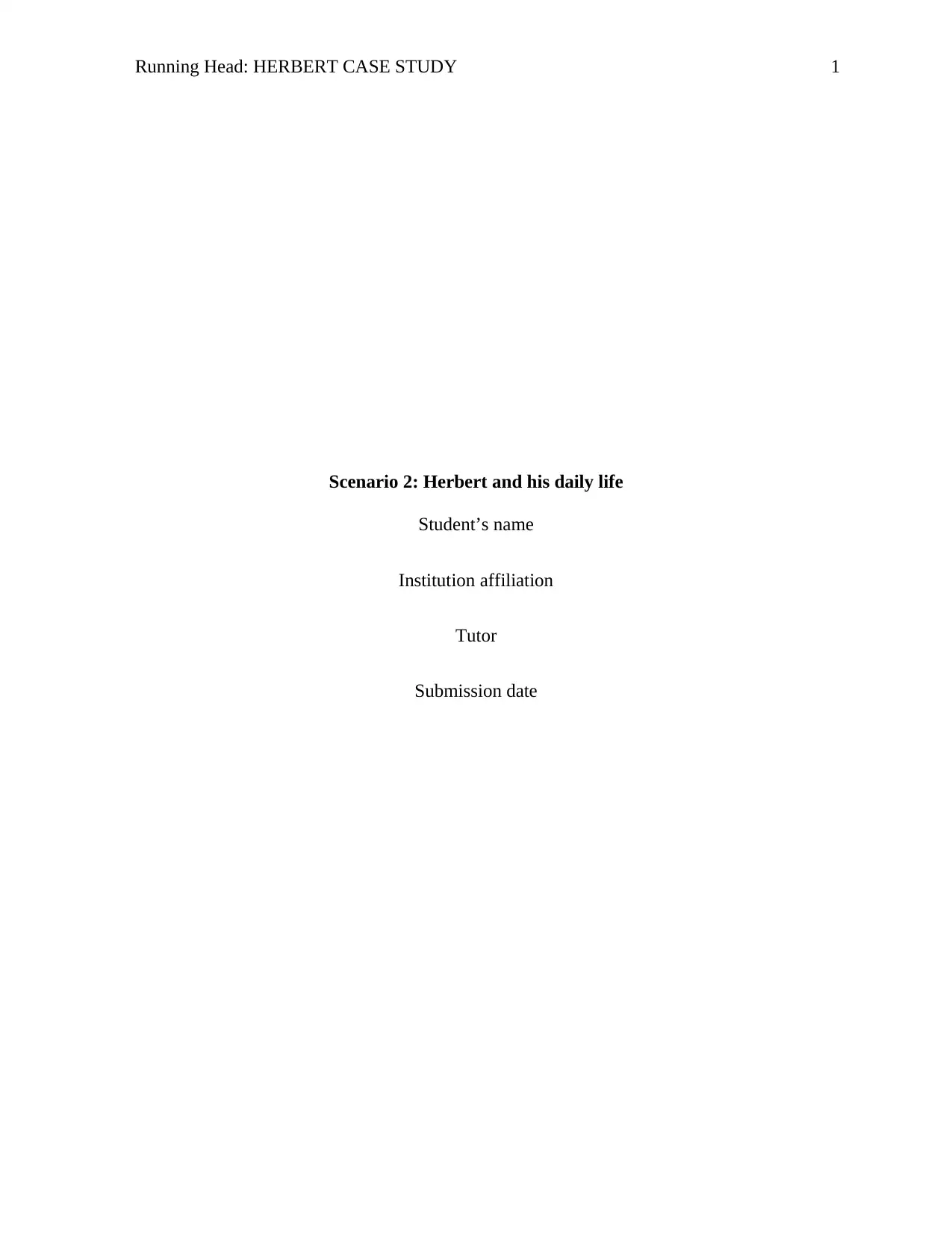
Running Head: HERBERT CASE STUDY 1
Scenario 2: Herbert and his daily life
Student’s name
Institution affiliation
Tutor
Submission date
Scenario 2: Herbert and his daily life
Student’s name
Institution affiliation
Tutor
Submission date
Paraphrase This Document
Need a fresh take? Get an instant paraphrase of this document with our AI Paraphraser
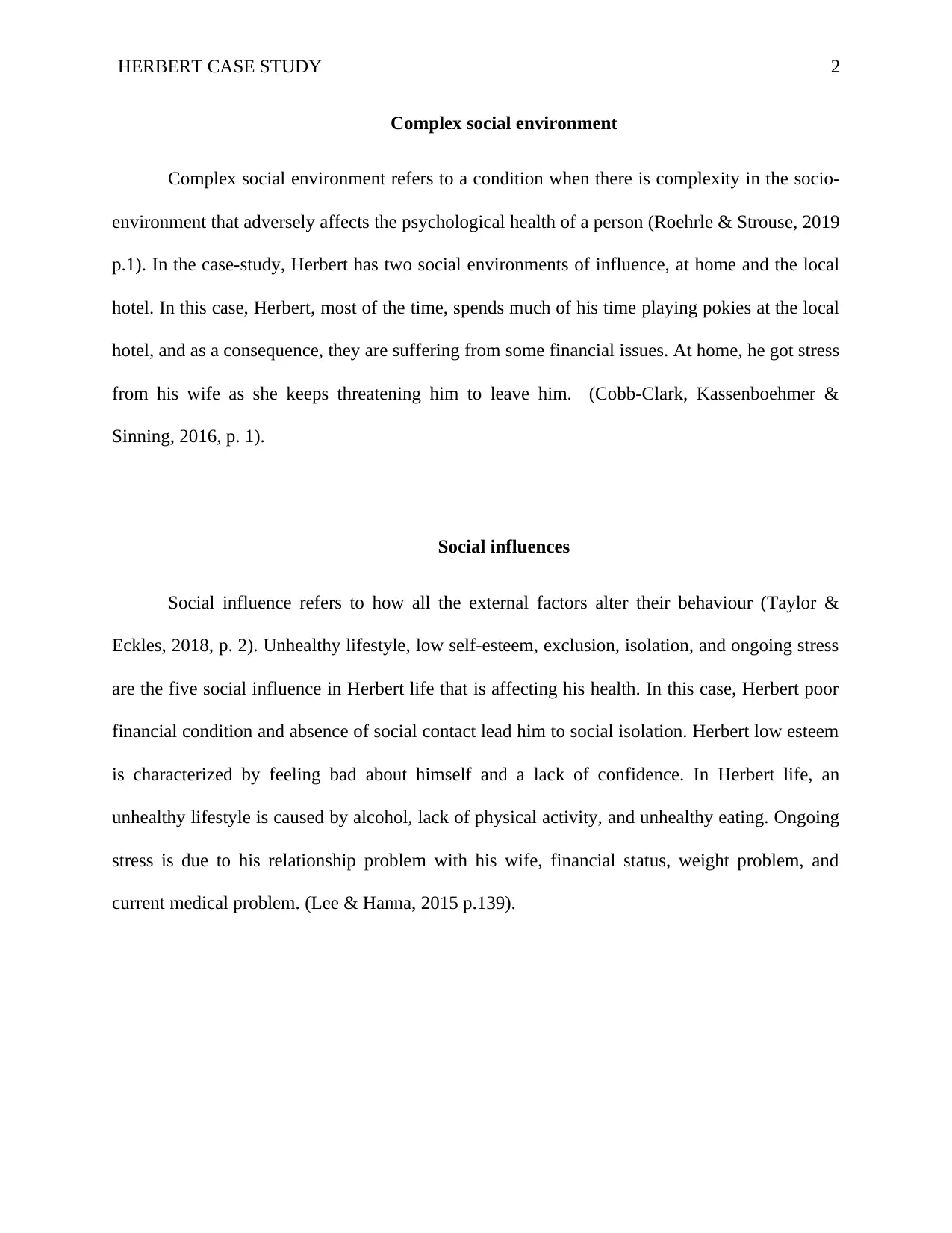
HERBERT CASE STUDY 2
Complex social environment
Complex social environment refers to a condition when there is complexity in the socio-
environment that adversely affects the psychological health of a person (Roehrle & Strouse, 2019
p.1). In the case-study, Herbert has two social environments of influence, at home and the local
hotel. In this case, Herbert, most of the time, spends much of his time playing pokies at the local
hotel, and as a consequence, they are suffering from some financial issues. At home, he got stress
from his wife as she keeps threatening him to leave him. (Cobb-Clark, Kassenboehmer &
Sinning, 2016, p. 1).
Social influences
Social influence refers to how all the external factors alter their behaviour (Taylor &
Eckles, 2018, p. 2). Unhealthy lifestyle, low self-esteem, exclusion, isolation, and ongoing stress
are the five social influence in Herbert life that is affecting his health. In this case, Herbert poor
financial condition and absence of social contact lead him to social isolation. Herbert low esteem
is characterized by feeling bad about himself and a lack of confidence. In Herbert life, an
unhealthy lifestyle is caused by alcohol, lack of physical activity, and unhealthy eating. Ongoing
stress is due to his relationship problem with his wife, financial status, weight problem, and
current medical problem. (Lee & Hanna, 2015 p.139).
Complex social environment
Complex social environment refers to a condition when there is complexity in the socio-
environment that adversely affects the psychological health of a person (Roehrle & Strouse, 2019
p.1). In the case-study, Herbert has two social environments of influence, at home and the local
hotel. In this case, Herbert, most of the time, spends much of his time playing pokies at the local
hotel, and as a consequence, they are suffering from some financial issues. At home, he got stress
from his wife as she keeps threatening him to leave him. (Cobb-Clark, Kassenboehmer &
Sinning, 2016, p. 1).
Social influences
Social influence refers to how all the external factors alter their behaviour (Taylor &
Eckles, 2018, p. 2). Unhealthy lifestyle, low self-esteem, exclusion, isolation, and ongoing stress
are the five social influence in Herbert life that is affecting his health. In this case, Herbert poor
financial condition and absence of social contact lead him to social isolation. Herbert low esteem
is characterized by feeling bad about himself and a lack of confidence. In Herbert life, an
unhealthy lifestyle is caused by alcohol, lack of physical activity, and unhealthy eating. Ongoing
stress is due to his relationship problem with his wife, financial status, weight problem, and
current medical problem. (Lee & Hanna, 2015 p.139).

HERBERT CASE STUDY 3
Inequalities
Inequality is defined as a situation where there is a lack of evenness. Moreover, this
situation can be reflected when individuals are not treated equally with others (Gimpelson &
Treisman, 2018, p.2). In Herbert case, he faces many health issues, strength problem, and
financial condition, but unlike other people of his society. In turns, all these inequality factors are
harmful because it put him in a hierarchy which reduces social cohesion, increase competition
for status, insecurity, and stress, leading him to poor health and other negative outcomes. An
example from the case study is when Herbert faces a situation of inequality due to age group.
Culture
Culture is a social behavior found in human societies that reflects ideas, customs of a
particular people or society (Storey, 2018, p.1). Poor lifestyle behavior is the cultural influence in
Herbert life that affecting his health. Eating junk food and drinking alcohol can be seen as a
status in some societies (Inglehart, 2018, p.34). On the case, it can be reflected in the behavior
culture of Herbert, where he changes his lifestyle of eating junk food and drinks much of the
wine. In turns, all these mechanisms lead him to obesity, alter blood pressure response and
decrease immunity, that place Herbert at risk for adverse health and functioning outcomes (Lee
& Hanna, 2015 p. 138).
Emotion and health
Inequalities
Inequality is defined as a situation where there is a lack of evenness. Moreover, this
situation can be reflected when individuals are not treated equally with others (Gimpelson &
Treisman, 2018, p.2). In Herbert case, he faces many health issues, strength problem, and
financial condition, but unlike other people of his society. In turns, all these inequality factors are
harmful because it put him in a hierarchy which reduces social cohesion, increase competition
for status, insecurity, and stress, leading him to poor health and other negative outcomes. An
example from the case study is when Herbert faces a situation of inequality due to age group.
Culture
Culture is a social behavior found in human societies that reflects ideas, customs of a
particular people or society (Storey, 2018, p.1). Poor lifestyle behavior is the cultural influence in
Herbert life that affecting his health. Eating junk food and drinking alcohol can be seen as a
status in some societies (Inglehart, 2018, p.34). On the case, it can be reflected in the behavior
culture of Herbert, where he changes his lifestyle of eating junk food and drinks much of the
wine. In turns, all these mechanisms lead him to obesity, alter blood pressure response and
decrease immunity, that place Herbert at risk for adverse health and functioning outcomes (Lee
& Hanna, 2015 p. 138).
Emotion and health
⊘ This is a preview!⊘
Do you want full access?
Subscribe today to unlock all pages.

Trusted by 1+ million students worldwide

HERBERT CASE STUDY 4
Psychosomatic can be defined as the physical disease which is caused or made worse by
mental factors (Fava, Cosci and Sanino, 2017 p.15). The body symptoms involve both the mind
and the body of the individual. This means the mental health of the individual, such as anxiety or
stress, can affect the physical state of the individual. This can be linked in the case where Herbert
feels fatigued or challenging to perform the manual task. These psychosomatic symptoms of
uniqueness or tiredness might be caused by psychological factors like his ongoing stress, worry,
and emotional upset. Cortisol, the main immunity module, is also known by main stress hormone
in the body, so any type of stressor will influence the immunity system (Fava, Cosci and Sanino,
2017 p.22).
Stress and stress management
Stress is a state of emotional or mental strain resulting from demanding and adverse
circumstances (Seaward, 2017, p. 25). There are two types of stressors in Herbert life are
eustress, which refers to positive stress and distress, which is the term for negative stress. In the
case study, he is experiencing eustress, where he seeks counseling from his friend. He is
experiencing distress due to his health, financial problem, and marriage difficulties. Moreover,
due to stress Herbert is forced to ask for the advice from the registered nurse so that to seek if
should change on the depression pill or not.
Stress management
Task focus approach can be defined as the situation where an individual invests in his
consciousness to solve his problems so that to minimize stress (Getachew, Tadesse, and
Teshome, 2017 p. 90). An example from the case study can be reflected where Herbert seeks
Psychosomatic can be defined as the physical disease which is caused or made worse by
mental factors (Fava, Cosci and Sanino, 2017 p.15). The body symptoms involve both the mind
and the body of the individual. This means the mental health of the individual, such as anxiety or
stress, can affect the physical state of the individual. This can be linked in the case where Herbert
feels fatigued or challenging to perform the manual task. These psychosomatic symptoms of
uniqueness or tiredness might be caused by psychological factors like his ongoing stress, worry,
and emotional upset. Cortisol, the main immunity module, is also known by main stress hormone
in the body, so any type of stressor will influence the immunity system (Fava, Cosci and Sanino,
2017 p.22).
Stress and stress management
Stress is a state of emotional or mental strain resulting from demanding and adverse
circumstances (Seaward, 2017, p. 25). There are two types of stressors in Herbert life are
eustress, which refers to positive stress and distress, which is the term for negative stress. In the
case study, he is experiencing eustress, where he seeks counseling from his friend. He is
experiencing distress due to his health, financial problem, and marriage difficulties. Moreover,
due to stress Herbert is forced to ask for the advice from the registered nurse so that to seek if
should change on the depression pill or not.
Stress management
Task focus approach can be defined as the situation where an individual invests in his
consciousness to solve his problems so that to minimize stress (Getachew, Tadesse, and
Teshome, 2017 p. 90). An example from the case study can be reflected where Herbert seeks
Paraphrase This Document
Need a fresh take? Get an instant paraphrase of this document with our AI Paraphraser
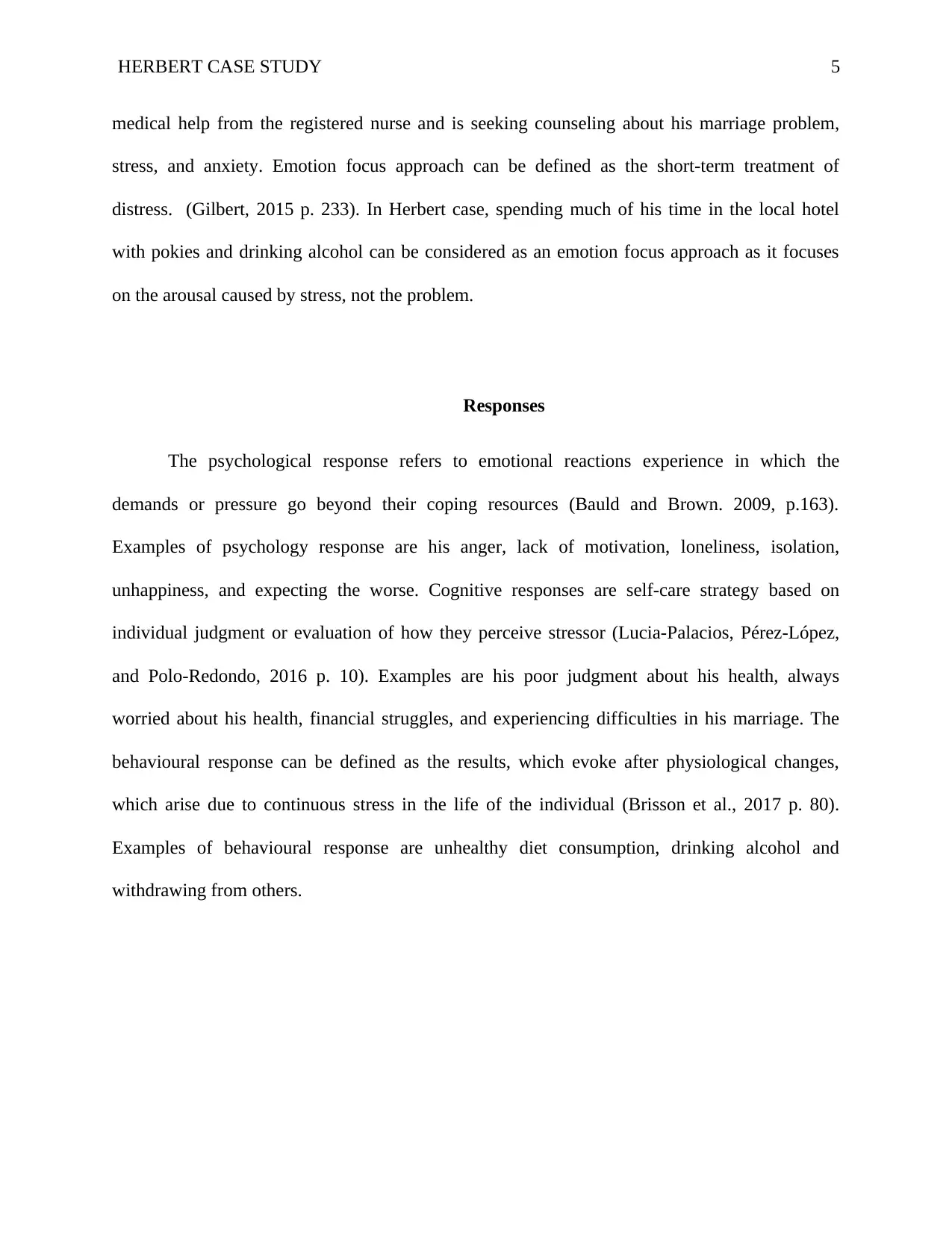
HERBERT CASE STUDY 5
medical help from the registered nurse and is seeking counseling about his marriage problem,
stress, and anxiety. Emotion focus approach can be defined as the short-term treatment of
distress. (Gilbert, 2015 p. 233). In Herbert case, spending much of his time in the local hotel
with pokies and drinking alcohol can be considered as an emotion focus approach as it focuses
on the arousal caused by stress, not the problem.
Responses
The psychological response refers to emotional reactions experience in which the
demands or pressure go beyond their coping resources (Bauld and Brown. 2009, p.163).
Examples of psychology response are his anger, lack of motivation, loneliness, isolation,
unhappiness, and expecting the worse. Cognitive responses are self-care strategy based on
individual judgment or evaluation of how they perceive stressor (Lucia-Palacios, Pérez-López,
and Polo-Redondo, 2016 p. 10). Examples are his poor judgment about his health, always
worried about his health, financial struggles, and experiencing difficulties in his marriage. The
behavioural response can be defined as the results, which evoke after physiological changes,
which arise due to continuous stress in the life of the individual (Brisson et al., 2017 p. 80).
Examples of behavioural response are unhealthy diet consumption, drinking alcohol and
withdrawing from others.
medical help from the registered nurse and is seeking counseling about his marriage problem,
stress, and anxiety. Emotion focus approach can be defined as the short-term treatment of
distress. (Gilbert, 2015 p. 233). In Herbert case, spending much of his time in the local hotel
with pokies and drinking alcohol can be considered as an emotion focus approach as it focuses
on the arousal caused by stress, not the problem.
Responses
The psychological response refers to emotional reactions experience in which the
demands or pressure go beyond their coping resources (Bauld and Brown. 2009, p.163).
Examples of psychology response are his anger, lack of motivation, loneliness, isolation,
unhappiness, and expecting the worse. Cognitive responses are self-care strategy based on
individual judgment or evaluation of how they perceive stressor (Lucia-Palacios, Pérez-López,
and Polo-Redondo, 2016 p. 10). Examples are his poor judgment about his health, always
worried about his health, financial struggles, and experiencing difficulties in his marriage. The
behavioural response can be defined as the results, which evoke after physiological changes,
which arise due to continuous stress in the life of the individual (Brisson et al., 2017 p. 80).
Examples of behavioural response are unhealthy diet consumption, drinking alcohol and
withdrawing from others.

HERBERT CASE STUDY 6
Reference
Atkinson, G., & Batterham, A. M. (2015). True and false interindividual differences in the physiological
response to an intervention. Experimental physiology, 100(6), 577-588.
Bauld, R., and Brown R. (2009). Stress, psychological distress, psychosocial factors, menopause
symptoms and physical health in women. Maturitas. 62(2), 160-165. doi:
10.1016/j.maturitas.2008.12.004
Brisson-Curadeau, É., Bird, D., Burke, C., Fifield, D. A., Pace, P., Sherley, R. B., & Elliott, K.
H. (2017). Seabird species vary in behavioural response to drone census. Scientific
reports, 7(1), 17884, 79-80
Cobb-Clark, D. A., Kassenboehmer, S. C., & Sinning, M. G. (2016). Locus of control and
savings. Journal of Banking & Finance, 73, 113-130.
Fava, G. A., Cosci, F., & Sonino, N. (2017). Current psychosomatic practice. Psychotherapy and
psychosomatics, 86(1), 13-30.
Furlong, C., De Silva, S., Guthrie, L., & Considine, R. (2016). Developing a water infrastructure
planning framework for the complex modern planning environment. Utilities Policy, 38,
1-10.
Reference
Atkinson, G., & Batterham, A. M. (2015). True and false interindividual differences in the physiological
response to an intervention. Experimental physiology, 100(6), 577-588.
Bauld, R., and Brown R. (2009). Stress, psychological distress, psychosocial factors, menopause
symptoms and physical health in women. Maturitas. 62(2), 160-165. doi:
10.1016/j.maturitas.2008.12.004
Brisson-Curadeau, É., Bird, D., Burke, C., Fifield, D. A., Pace, P., Sherley, R. B., & Elliott, K.
H. (2017). Seabird species vary in behavioural response to drone census. Scientific
reports, 7(1), 17884, 79-80
Cobb-Clark, D. A., Kassenboehmer, S. C., & Sinning, M. G. (2016). Locus of control and
savings. Journal of Banking & Finance, 73, 113-130.
Fava, G. A., Cosci, F., & Sonino, N. (2017). Current psychosomatic practice. Psychotherapy and
psychosomatics, 86(1), 13-30.
Furlong, C., De Silva, S., Guthrie, L., & Considine, R. (2016). Developing a water infrastructure
planning framework for the complex modern planning environment. Utilities Policy, 38,
1-10.
⊘ This is a preview!⊘
Do you want full access?
Subscribe today to unlock all pages.

Trusted by 1+ million students worldwide
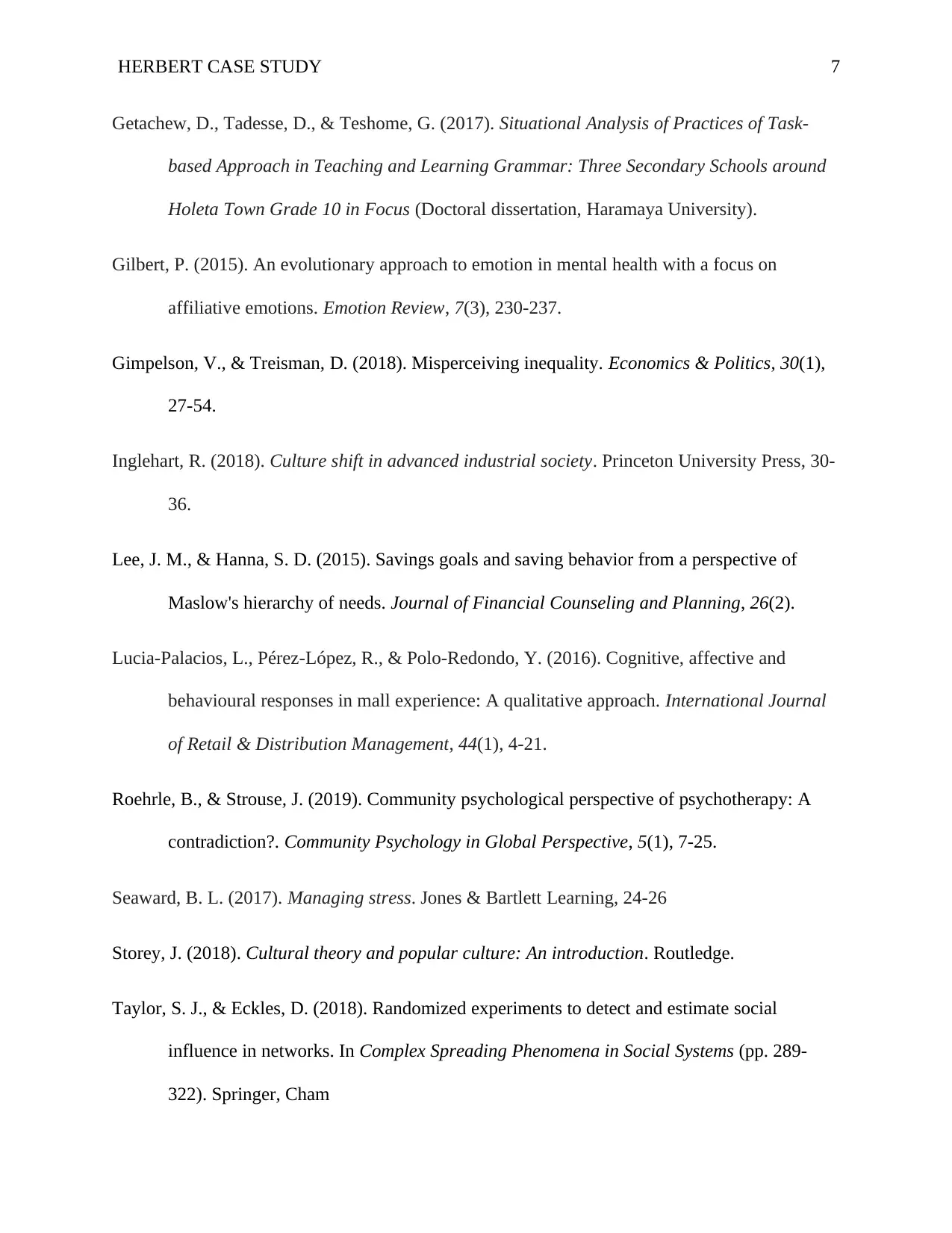
HERBERT CASE STUDY 7
Getachew, D., Tadesse, D., & Teshome, G. (2017). Situational Analysis of Practices of Task-
based Approach in Teaching and Learning Grammar: Three Secondary Schools around
Holeta Town Grade 10 in Focus (Doctoral dissertation, Haramaya University).
Gilbert, P. (2015). An evolutionary approach to emotion in mental health with a focus on
affiliative emotions. Emotion Review, 7(3), 230-237.
Gimpelson, V., & Treisman, D. (2018). Misperceiving inequality. Economics & Politics, 30(1),
27-54.
Inglehart, R. (2018). Culture shift in advanced industrial society. Princeton University Press, 30-
36.
Lee, J. M., & Hanna, S. D. (2015). Savings goals and saving behavior from a perspective of
Maslow's hierarchy of needs. Journal of Financial Counseling and Planning, 26(2).
Lucia-Palacios, L., Pérez-López, R., & Polo-Redondo, Y. (2016). Cognitive, affective and
behavioural responses in mall experience: A qualitative approach. International Journal
of Retail & Distribution Management, 44(1), 4-21.
Roehrle, B., & Strouse, J. (2019). Community psychological perspective of psychotherapy: A
contradiction?. Community Psychology in Global Perspective, 5(1), 7-25.
Seaward, B. L. (2017). Managing stress. Jones & Bartlett Learning, 24-26
Storey, J. (2018). Cultural theory and popular culture: An introduction. Routledge.
Taylor, S. J., & Eckles, D. (2018). Randomized experiments to detect and estimate social
influence in networks. In Complex Spreading Phenomena in Social Systems (pp. 289-
322). Springer, Cham
Getachew, D., Tadesse, D., & Teshome, G. (2017). Situational Analysis of Practices of Task-
based Approach in Teaching and Learning Grammar: Three Secondary Schools around
Holeta Town Grade 10 in Focus (Doctoral dissertation, Haramaya University).
Gilbert, P. (2015). An evolutionary approach to emotion in mental health with a focus on
affiliative emotions. Emotion Review, 7(3), 230-237.
Gimpelson, V., & Treisman, D. (2018). Misperceiving inequality. Economics & Politics, 30(1),
27-54.
Inglehart, R. (2018). Culture shift in advanced industrial society. Princeton University Press, 30-
36.
Lee, J. M., & Hanna, S. D. (2015). Savings goals and saving behavior from a perspective of
Maslow's hierarchy of needs. Journal of Financial Counseling and Planning, 26(2).
Lucia-Palacios, L., Pérez-López, R., & Polo-Redondo, Y. (2016). Cognitive, affective and
behavioural responses in mall experience: A qualitative approach. International Journal
of Retail & Distribution Management, 44(1), 4-21.
Roehrle, B., & Strouse, J. (2019). Community psychological perspective of psychotherapy: A
contradiction?. Community Psychology in Global Perspective, 5(1), 7-25.
Seaward, B. L. (2017). Managing stress. Jones & Bartlett Learning, 24-26
Storey, J. (2018). Cultural theory and popular culture: An introduction. Routledge.
Taylor, S. J., & Eckles, D. (2018). Randomized experiments to detect and estimate social
influence in networks. In Complex Spreading Phenomena in Social Systems (pp. 289-
322). Springer, Cham
Paraphrase This Document
Need a fresh take? Get an instant paraphrase of this document with our AI Paraphraser
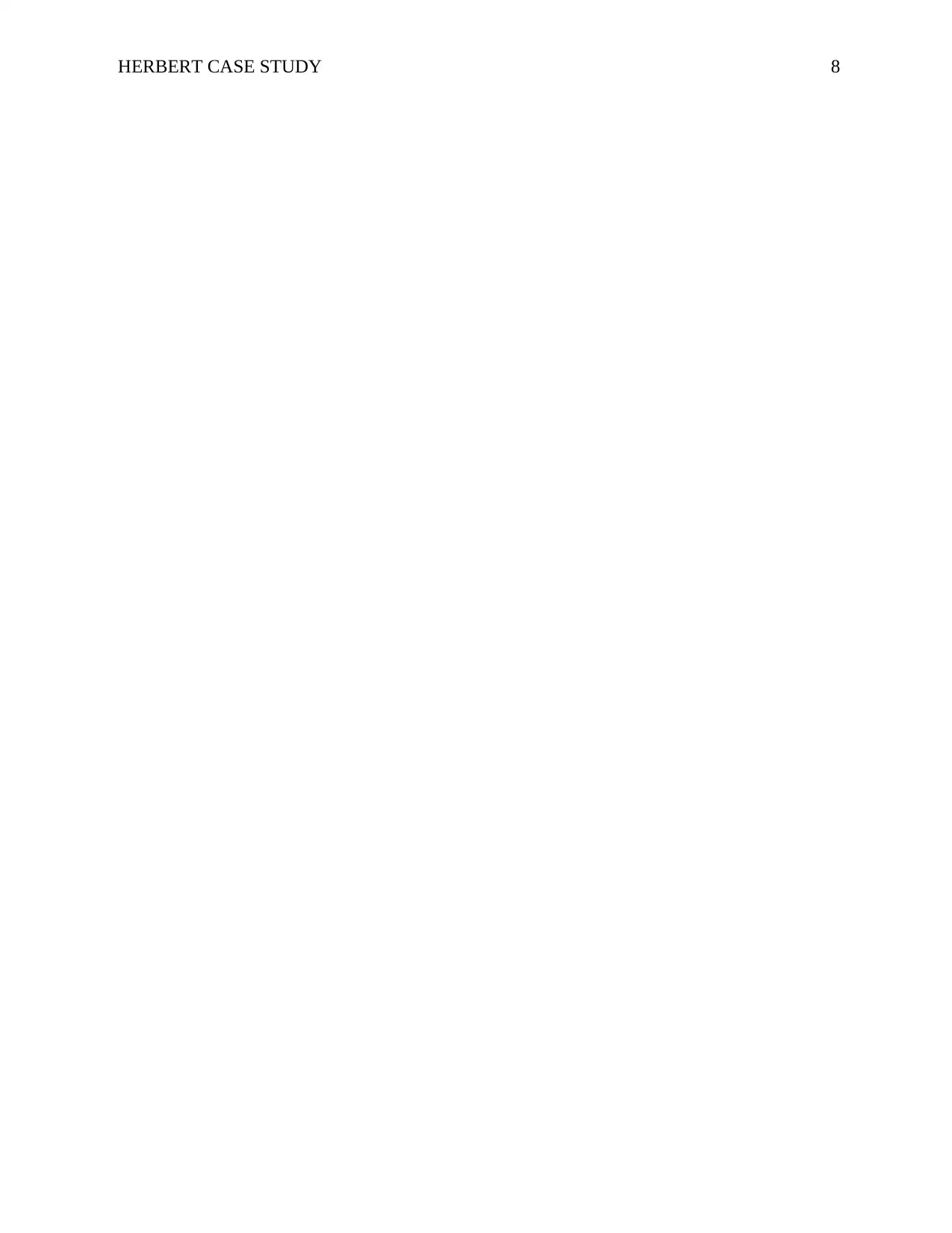
HERBERT CASE STUDY 8
1 out of 8
Related Documents
Your All-in-One AI-Powered Toolkit for Academic Success.
+13062052269
info@desklib.com
Available 24*7 on WhatsApp / Email
![[object Object]](/_next/static/media/star-bottom.7253800d.svg)
Unlock your academic potential
Copyright © 2020–2025 A2Z Services. All Rights Reserved. Developed and managed by ZUCOL.





